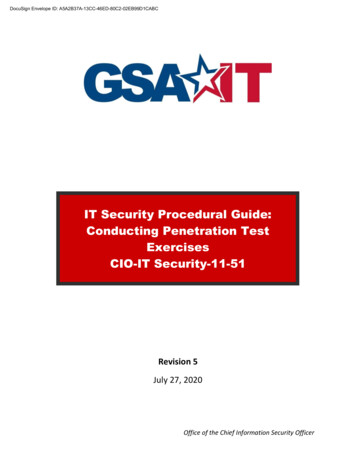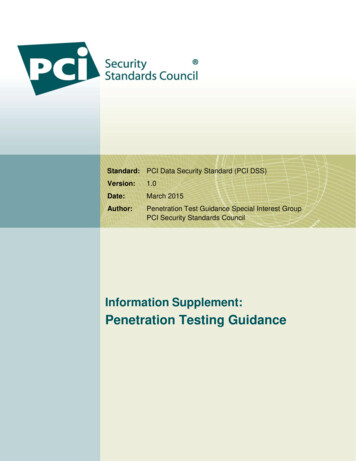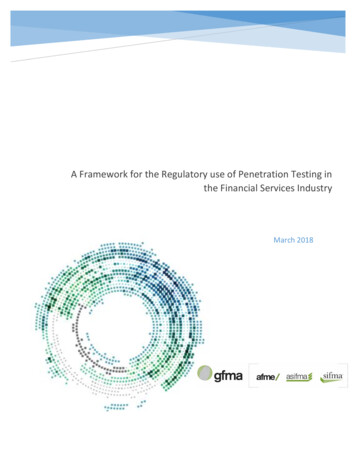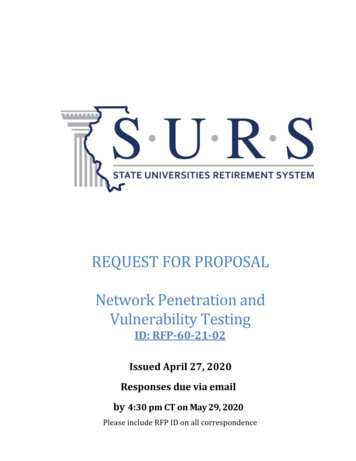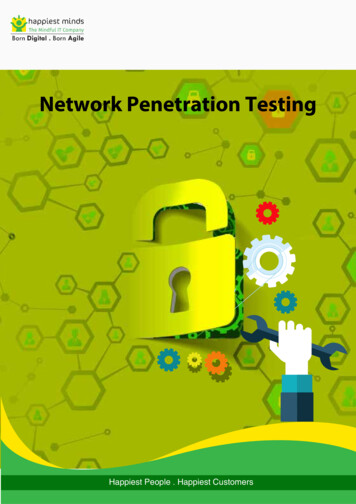
Transcription
Network Penetration TestingHappiest People . Happiest Customers
ContentsAbstract.3Introduction.3Why Penetration Test?.3Need for Omni-Channel.3Types of Penetration Testing.3 External Network Penetration Testing.3 Internal Network Penetration Testing .3Penetration Testing – Approach and Methodology.4 Profiling.4 Discovery & Enumeration.4 Scanning.4 Exploitation.5 Reporting.5 Reference – Testing for system takeover.5 Tools and Techniques.6The best practices and recommendations.62 Happiest Minds Technologies. All Rights Reserved
AbstractTypes of Penetration TestingPenetration Testing is an authorized, proactive attempt toExternal Network Penetration Testingmeasure the security of an IT system by safely exploitingThe goal of the external network Penetration Testing is toits vulnerabilities, mostly to evaluate application flaws,demonstrate the existence of known security vulnerabilitiesimproper configurations, risky end-user behavior. Be thatthat could be exploited by an attacker as they appear outsideas it may, why would you voluntarily perform a self-hack inthe perimeter of the network, usually from the internet.the first place? What are the different types of PenetrationExternal testing involves analysis of publicly available infor-Testing? What are the principal approaches, methodolo-mation, a network enumeration phase and the behavior of thegies, tools, techniques and the best practices of thesecurity devices is analyzed. It is the traditional approach tosame? This whitepaper interestingly addresses the abovePenetration Testing and it involves assessing the servers,concerns and throws light on this subject in more detail.technology infrastructure and the underlying software com-Introductionprising the target. It is performed with no prior knowledge ofA Network Penetration Testing is crucial to demystify iden-firewalls, routers, IDPS, etc should undergo the Penetrationthe target environment. All web servers, mail servers,tify the security exposures that are used to surface whenTesting activity to evaluate the security posture.launch a cyber-attacks are launched from internet andInternal Network Penetration Testingintranet. The security assessment of internet / intranetInternal network Penetration Testing reveals the holistic viewfacing system test helps discover the vulnerable networkservices that can be exploited by unknown threat sourcesThe common categories of vulnerabilities present innetworks can personify polar differences in characters. Itcan vary from remote system & password compromise,web server, database, network service, network device,directory and miscellaneous non-configuration to information disclosure to weak cryptography. This array of vulnerabilities propel the imperative need for a holistic Penetration Testing Process.Why Penetration Test?of the security posture of the organization.An internal network security assessment follows a similartechnique to external assessment but with a more completeview of the site security. Testing will be performed from anumber of network access points, representing each logicaland physical network segments. For example, this mayinclude tiers and DMZ’s within the environment, the corporatenetwork or partner company connections. Internal networkPenetration Testing is used to determine If a disgruntled internal employee of the organization penetrates the network withthe amount of IT knowledge he has, If a hacker breaks intothe internal network by compromising the weak perimetersecurity controls and steals the sensitive information and IfApart from the host of afore mentioned vulnerabilities, thethe guest visitor walks by the company and steals sensitivereasons that press harder for the need for Penetrationdata from the internal network.Testing encompass concerns like threat identification,perimeter security evaluation, certification of industryregulations, IT security cost control, anti-vulnerabilitysolutions, legal compliance, validation of security protection and most importantly, justify return on security investment. While Penetration Testing as a generic phenomenon helps improve the operational efficiency of IT security,different types of Penetration Testing addresses differentconcerns. Types of Penetration Testing:3 Happiest Minds Technologies. All Rights Reserved
Penetration Testing – Approach and MethodologyDNSMxToolboxGoogle SearchesIdentificationof targetsWHOISClient InputsPort ScanningCentralOpsFoot-printing icesIdentification lowsexploitation?Web ServersYesNon-destructiveexploitation ofvulnerabilitiesDeeper network Penetration;exploit all Possible vulnerabilitiesResult collationand report writingProfilingProfiling involves gathering as much as information as possible about the target network for discovering the possible ways toenter into the target organization. This involves determining the target operation systems, web server versions, DNS information, platforms running, existence of vulnerabilities & exploits for launching the attacks. The information can be gathered usingvarious techniques such as Whois lookup, enquiring the DNS entries, google searches (using GHDB), social networking sites,emails, websites, etc.Discovery & EnumerationDiscovery involves using the automated tools and manual techniques to identify the live hosts present in the network, determining the target system’s operating system through banner grabbing, presence of open ports, services running, & versionsof the services, technology information, protocols and its version.Enumerating an internal network allows the penetration tester to identify the network resources, & shares, users & groupsusers, groups, routing tables, audit & serviceaudit, service settings, machine names, applications & bannersapplications,banners and protocols & with its details. The identified information would allow the Penetration tTester to identify systemattack points and perform password attacks to gain unauthorized access to informationsystems.ScanningScanning involves identifying the vulnerabilities present in network services, information systems and perimeter securitycontrols by enterprise class tools with most updated feeds, and using the best manual scripts. In addition, manual assessments helps eliminating the false positives reported by the tools and to identify the false negatives.Scanning will identify network topology & OS vulnerabilities, application & services vulnerabilities, application & servicesconfiguration errors, etc. In the scanning phase, the pPenetration tTester will identify exploits and evaluate attack surfacearea.4 Happiest Minds Technologies. All Rights Reserved
ExploitationThis stage uses the information gathered on active ports and services with the related vulnerabilities to safely exploit theservices exposed. Attack scenarios for production environment will use a combination of exploit payloads in strict accordance with agreed rules of engagement.It involves research, test exploits and launch payloads against the target environment using Penetration tTest frameworks such as meta-sploit.ReportingAll exploitable security vulnerabilities in the target system are recorded with associated CVSS v2 based scores are reportedto the client. The identified security vulnerability is thoroughly assessed and reported along with appropriate recommendation or mitigation measures.Reference – Testing for system takeover Identifying and determine the status of vulnerable service on port 6667 on remote system Selecting and launching the relevant attack exploit and payload to compromise the remote system5 Happiest Minds Technologies. All Rights Reserved
Tools and TechniquesCategoryToolsFrameworksKali Linux, Backtrack5 R3, Security OnionReconnaisanceSmartwhois, MxToolbox, CentralOps, dnsstuff, nslookup, DIG, netcraft,DiscoveryAngry IP scanner, Colasoft ping tool, nmap, Maltego, NetResident,LanSurveyor, OpManagerPort ScanningNmap, Megaping, Hping3, Netscan tools pro, Advanced port scannerService FingerprintingXprobe, nmap, zenmapEnumerationSuperscan, Netbios enumerator, Snmpcheck, onesixtyone, Jxplorer, Hyena,DumpSec, WinFingerprint, Ps Tools, NsAuditor, Enum4Linux, nslookup, NetscanScanningNessus, GFI Languard, Retina, SAINT, NexposePassword CrackingNcrack, Cain & Abel, LC5, Ophcrack, pwdump7, fgdump, John The Ripper,Rainbow CrackSniffingWireshark, Ettercap, Capsa Network AnalyzerMiTM AttacksCain & Abel, EttercapExploitationMetasploit, Core ImpactThe best practices and recommendationsThe following are the best practices that could be followed in applying the defense in depth strategy acrossthe internal network services Establish technical standards for Systems Security & Network Security device hardening Security assessments to be integrated with change management processes to avoid introduction ofvulnerability in the technology environments Patch and vulnerability management must be tracked closely with platform teams or system owners Firewall configuration reviews and change management must be conducted periodically Periodically conducted internal and external network security assessment that include compliance checksagainst the build standards, if package operating systems (i.e. hardened builds) are deployed across theorganization Security benchmark can be found on center for internet security6 Happiest Minds Technologies. All Rights Reserved
About the AuthorKarthik PalanisamyKarthik Palanisamy, Technical Security Assessment Professional with 4 plus years of consulting experience in network & web application vulnerability assessment and penetration testing, thick client security,database security, mobile application security, SAP application penetration testing, source code audit,configuration review of devices and security architecture review (Applications and Infrastructures).Currently holding a position with Happiest Minds Technologies to deliver technical security assessment andpenetration testing services covering application security, infrastructures security, mobile applicationsecurity and source code review.About Happiest MindsHappiest Minds, the Mindful IT Company, applies agile methodologies to enable digital transformation for enterprises andtechnology providers by delivering seamless customer experience, business efficiency and actionable insights. We leverage aspectrum of disruptive technologies such as: Big Data Analytics, AI & Cognitive Computing, Internet of Things, Cloud,Security, SDN-NFV, RPA, Blockchain, etc. Positioned as “Born Digital . Born Agile”, our capabilities spans across productengineering, digital business solutions, infrastructure management and security services. We deliver these services acrossindustry sectors such as retail, consumer packaged goods, edutech, e-commerce, banking, insurance, hi-tech, engineeringR&D, manufacturing, automotive and travel/transportation/hospitality.Headquartered in Bangalore, India; Happiest Minds has operations in USA, UK, The Netherlands, Australia and Middle East. Happiest Minds. All Rights Reserved.Business Contact: business@happiestminds.comVisit us: www.happiestminds.comFollow us onThis Document is an exclusive property of Happiest Minds Technologies12 Happiest Minds Technologies. All Rights Reserved
Internal network Penetration Testing reveals the holistic view of the security posture of the organization. An internal network security assessment follows a similar technique to external assessment but with a more complete view of the site security. Testing will be performed from a number of

